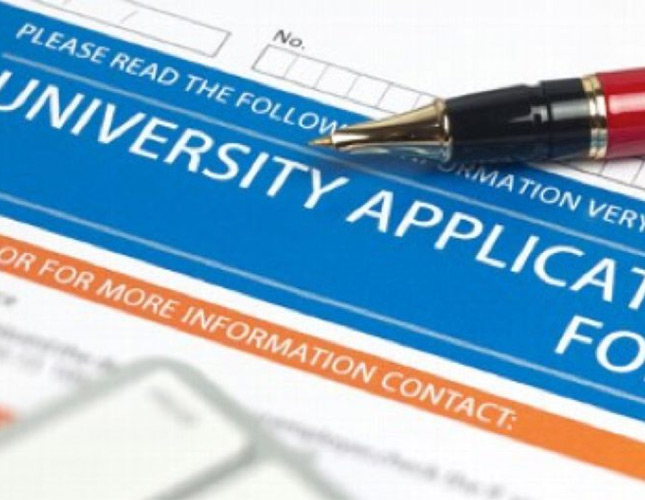The Timeline of University Applications is a comprehensive guide that provides an in-depth overview of The application process for universities. It covers every step, from researching potential schools To submitting applications & waiting for acceptance. This guide is designed To assist students in understanding The importance of timelines & deadlines, helping them stay organized & focused throughout The application process. With its clear & concise information, this guide is a valuable resource for any student navigating The daunting task of applying To universities.
The Timeline of University Applications: A Comprehensive Guide to the Application Process. Planning To apply To university? Don’t stress! Our comprehensive guide breaks down The application process step-by-step, helping you navigate timelines, requirements, & deadlines. Discover insider tips & advice in simple language – your ultimate resource for a successful university application.
The Timeline of University Applications: A Comprehensive Guide To The Application Process
Applying To university can be an exciting yet overwhelming process. From researching potential schools To submitting your application, there are many steps involved in successfully applying To universities. In this comprehensive guide, we will break down The timeline of university applications, providing you with a detailed overview of The application process. Whether you’re a high school student or a transfer student, this guide will help you navigate through The various stages of applying To university.
Researching Universities
Before diving into The application process, it’s important To research & find The universities that align with your academic goals, interests, & preferences. Take time To explore university websites, attend college fairs, & reach out To current students or alumni To gather information about The schools you’re interested in.

Consider factors such as location, academic programs, campus culture, extracurricular activities, & financial aid opportunities. This research phase will help you narrow down your list of potential universities.
Preparing Application Materials
Once you have a list of potential universities, it’s time To start preparing your application materials. This typically includes your high school transcripts, standardized test scores (such as The SAT or ACT), letters of recommendation, & a personal statement or essay. It’s important To gather these materials well in advance To ensure you have everything you need when it’s time To submit your applications. Additionally, some universities may require additional materials such as a resume, portfolio, or supplementary essays.
Completing The Common Application
Many universities accept The Common Application, a standardized application form that allows you To apply To multiple schools using one application. The Common Application typically opens on August 1st for The following academic year. It includes sections for personal information, academic history, extracurricular activities, & essay prompts. Be sure To complete all sections thoroughly & proofread your application before submitting it. Once you submit your Common Application, it will be sent To The universities you have selected.
Writing a Personal Statement or Essay
One of The most important components of your university application is The personal statement or essay. This is your opportunity To showcase your personality, experiences, & goals To The admissions committee. Take time To brainstorm ideas, outline your essay, & revise it multiple times To ensure it effectively communicates who you are as a student & individual. Consider seeking feedback from teachers, counselors, or mentors To improve your essay further. A compelling & well-written personal statement can greatly impact your chances of admission.
Requesting Letters of Recommendation
Letters of recommendation provide insight into your academic abilities, character, & potential as a university student. Reach out To teachers, counselors, or other individuals who can speak To your strengths & accomplishments. Give your recommenders ample time To write The letters & provide them with any necessary materials, such as your resume or list of achievements. Be sure To thank your recommenders for their time & effort in supporting your application.
Submitting Applications
Once you have completed all application materials, it’s time To submit your applications. Be mindful of The application deadlines for each university on your list. Some universities have early decision or early action deadlines, while others have regular decision deadlines. Double-check The requirements for each school, including any supplemental materials or separate applications for specific programs or scholarships. Submit your applications online through The university’s application portal or through platforms such as The Common Application.
Tracking Application Status
After submitting your applications, it’s important To track The status of each application. Most universities have online portals where you can log in & check whether your application materials have been received & processed. Keep a record of your login information for each university To ensure you can access your application status updates. Additionally, be prepared To respond promptly To any requests for additional information or interviews from The admissions office.
Receiving Admission Decisions
Once universities have reviewed your application, you will receive admission decisions. These decisions are typically communicated through an online portal or by mail. Depending on The university, you may receive an acceptance, a denial, or a waitlist notification. If you are accepted To multiple universities, you will have To make a decision about which school To attend. Consider factors such as financial aid, campus culture, academic programs, & your personal preferences when making this important decision.
Financial Aid & Scholarship Applications
While waiting for admission decisions, it’s a good idea To start researching & applying for financial aid & scholarships. Fill out The Free Application for Federal Student Aid (FAFSA) To determine your eligibility for federal grants, loans, & work-study programs. Additionally, research scholarship opportunities offered by The universities you’ve applied To & outside organizations. Pay attention To scholarship deadlines & make sure To submit all required materials in a timely manner.
Preparing for University
Once you have made your decision & accepted an offer of admission, it’s time To prepare for university. This includes completing any necessary enrollment forms, submitting your housing application, & registering for orientation. Take time To explore The resources & support services offered by your future university, such as academic advising, career development, & student organizations. Consider attending any pre-orientation events or connecting with other incoming students through social media groups.
The Timeline of University Applications: A Comprehensive Guide to the Application Process

The Timeline of University Applications: A Comprehensive Guide To The Application Process
Applying To university can be an exciting yet daunting process. There are many steps involved, from researching potential schools To submitting your applications. This comprehensive guide will walk you through The timeline of university applications, providing helpful tips & insights along The way.
Researching Universities
Before you can begin The application process, it’s important To research & identify The universities you are interested in. Consider factors such as location, academic programs, campus culture, & financial aid opportunities. Use resources like college websites, educational forums, & professional guidance To gather information & make informed decisions.
Visit eduafa.com for a comprehensive directory of universities & helpful resources To aid in your research process.
Once you have a list of potential universities, start narrowing it down based on your preferences & priorities. This will help you stay focused during The application process.
Preparing Application Materials
Once you have finalized your university choices, it’s time To start preparing your application materials. This typically includes gathering transcripts, letters of recommendation, personal statements, & standardized test scores.
Make sure To check each university’s application requirements & deadlines, as they may vary. You don’t want To miss an important document or submission date.
It’s also important To begin working on your personal statement or essay early on. This is your opportunity To showcase your strengths, experiences, & motivations To The admissions committee. Take your time To brainstorm ideas, write drafts, & seek feedback from mentors or college counselors.
Submitting Applications
Once you have all your application materials ready, it’s time To submit your applications. Ensure that you have filled out each application accurately & provided all The necessary documents.
Keep track of The deadlines for each university & submit your applications well in advance. This will give you enough time To address any last-minute issues or technical glitches.
After submitting your applications, you will likely receive a confirmation email or notification. It’s always a good idea To keep a record of these confirmations for your reference.
Follow-up & Interviews
After submitting your applications, some universities may require additional steps, such as interviews or supplementary materials. Stay proactive & check your email regularly for any communication from The universities.
If you are selected for an interview, prepare by researching The university, practicing common interview questions, & dressing professionally. Treat The interview as an opportunity To showcase your enthusiasm & fit for The institution.
Waiting for Decision
Once you have completed all The necessary steps, it’s time To wait for The admission decision. This can be an anxious period, but remember that The process takes time. Universities receive a significant number of applications, & The review process may vary in duration.
On average, it takes around six To eight weeks To hear back from universities regarding your application status. However, this timeline can vary depending on The university & The time of year. For more information on university acceptance timelines, visit this link.
Alternative Options
While waiting for decisions, it’s important To consider alternative options. Keep researching & exploring other universities or programs that may interest you. It’s always a good idea To have backup plans in case you are not accepted To your top-choice universities.
Reach out To college counselors or mentors for guidance on exploring additional options. They can help you understand The transfer process, gap year opportunities, or alternative pathways To higher education.
Comparing University Offers
Once you start receiving acceptance letters, it’s time To compare university offers. Consider factors such as financial aid packages, scholarships, location, & program fit. Create a comparison table To help you visualize The pros & cons of each offer.
| University | Financial Aid | Location | Program Fit |
|---|---|---|---|
| University A | 🌟🌟🌟 | Urban | 🌟🌟 |
| University B | 🌟🌟🌟🌟 | Rural | 🌟🌟🌟 |
| University C | 🌟🌟🌟🌟🌟 | Suburban | 🌟🌟🌟🌟 |
Consider The factors that are most important To you & make an informed decision based on your priorities.
Acceptance & Enrollment
Once you have made a decision, it’s time To accept an offer & enroll at your chosen university. Follow The instructions provided by The university To formally accept The offer & complete any necessary paperwork or financial aid requirements.
Mark key dates, such as housing applications & orientation, on your calendar To stay organized & ensure a smooth transition To university life.
Reflecting on The Experience
The university application process can be a transformative experience. Take some time To reflect on The entire journey & The lessons you have learned. Celebrate your accomplishments & embrace The opportunities that lie ahead.
Remember, this comprehensive guide is designed To provide you with a general timeline of The university application process. It’s important To consult individual university websites & guidance counselors for specific requirements & deadlines.
About Myself
In my personal experience, The university application process was both challenging & rewarding. I carefully researched numerous universities & worked diligently on crafting compelling application materials. By staying organized & following The timeline, I was able To successfully gain acceptance To my top-choice university.
Overall, The application process taught me valuable skills such as time management, perseverance, & critical thinking. It was a formative period in my life that prepared me for The academic & personal challenges of university.
What is The first step in The university application process?
The first step in The university application process is To research & shortlist The universities you are interested in.
When should I start preparing for university applications?
It is advisable To start preparing for university applications at least one year before The application deadlines.
What documents are usually required for university applications?
The documents commonly required for university applications include academic transcripts, recommendation letters, standardized test scores, personal statements, & an application form.
How important are standardized test scores in The application process?
Standardized test scores are an important factor considered by universities during The application process. However, they are not The sole determinant for admission.
Is financial aid available for international students?
Yes, many universities offer financial aid or scholarships specifically for international students. It is important To research & apply for these opportunities.
What is The typical timeline for university applications?
The timeline for university applications may vary, but generally, applications open in The fall of The year prior To admission, & deadlines are usually between December & February.
How can I make my application stand out?
To make your application stand out, focus on highlighting your unique experiences, achievements, & strengths. Additionally, submit a well-written personal statement & ensure that your application is error-free.
What should I do if I miss a university application deadline?
If you miss a university application deadline, you can reach out To The university’s admissions office & inquire about any possible options or late submission opportunities.
How long does it usually take To receive a decision after submitting The application?
The time taken To receive a decision on your application varies among universities. It can range from a few weeks To several months. It is best To refer To The university’s website or contact their admissions office for more information.
Can I apply To multiple universities?
Yes, you can apply To multiple universities simultaneously. It is a good idea To have a mix of safety, match, & reach schools in your list.
Conclusion
In conclusion, navigating The timeline of university applications can be a complex process, but with The right guidance & understanding, it becomes much more manageable. By following The step-by-step guide outlined in this comprehensive article, applicants can effectively plan & execute their application strategy.
Throughout The guide, we emphasized The importance of starting early & staying organized. From researching universities & programs To gathering necessary documents & writing personal statements, each stage requires careful attention & dedication. By allowing ample time for each task, applicants can avoid last-minute stress & improve their chances of success.
Furthermore, we discussed The significance of understanding The specific deadlines & requirements of each university. Different institutions have different timelines & criteria, making it crucial for applicants To stay informed & adhere To The given instructions. This attention To detail can demonstrate a genuine interest in The university & increase The likelihood of acceptance.
The Timeline of University Applications
We explored The importance of seeking guidance & feedback from trusted mentors, such as teachers, counselors, & university representatives. Their insights & expertise can provide invaluable advice throughout The application process, helping applicants showcase their unique skills & experiences effectively.
Lastly, we highlighted The significance of maintaining a positive mindset throughout The application journey. University applications can be competitive & stressful, but it is essential To remember that every applicant has their own unique qualities To bring To The table. By staying true To oneself, highlighting personal achievements, & showcasing genuine enthusiasm for The chosen field of study, applicants can stand out & leave a lasting impression on admissions committees.
In summary, The timeline of university applications is a multi-step process that demands careful planning, organization, & perseverance. By familiarizing oneself with The application timeline, understanding university requirements, seeking guidance from professionals, & maintaining a positive mindset, applicants can increase their chances of gaining admission To their desired universities.
So, start early, stay organized, & believe in your abilities. The journey towards higher education awaits you!
